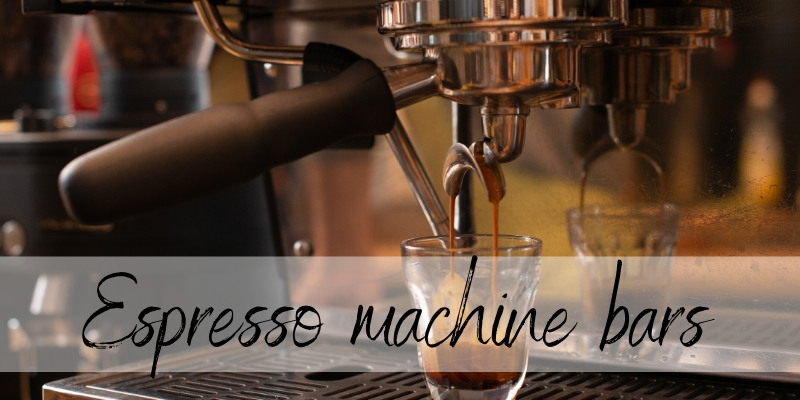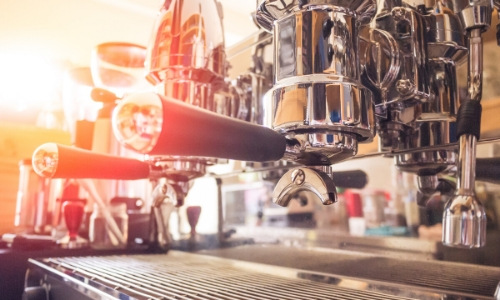Espresso is one of the most well-known coffee types all over the whole world. To produce a high extraction, it requires some components for a perfect taste.
Besides proper pressure, it's necessary to use a precise amount of coffee, a suitable grind size, the properly tamped coffee, a good quality water (best if bottled or filtered), a correct water temperature, and a perfect time of contact between water and coffee.
But speaking of pressure, there are some common questions out there.
What is it, and how many bars do you need for a good espresso ?
Is there a difference in pressure between professional espresso machines and home use machines?
Table of Contents
What are bars in an espresso machine?
In an espresso machine bars are used to measure the force with which the hot water is pushed through the ground coffee, in order to extract it.
To manage this pressure in the right extraction, the coffee must be a puck with a compact and uniform surface area that will offer resistance to the water.
Normally, the higher the pressure the stronger the coffee but there is a sweet spot for espresso machines.
That spot is 9 bars, and anything higher or lower may result in a poor coffee.
The atmospheric air pressure is measured in bars, which indicates the force exerted by the atmosphere, or the weight of air at sea level. The formula for determining this force is 1 bar = 1.47 pounds per square inch (psi).
So, when we talking about espresso machines: 9 bars = 130 psi and 15 bars= 217 psi.
This also means that espresso machines situated at very high altitudes may need a higher number of bars, despite 9 being the sweet spot. It's mostly due to atmospheric differences, and it won't be more than a couple of bars.
How many bars for a good espresso?
It's well known in every barista course or book that 9 bars is the perfect pressure for producing an espresso.
So it is practically the ideal pressure for espresso machines since the machine was invented. It was discovered that at this level of pressure, the extraction has the perfect taste, but can fluctuate between 8 and 10 bars.
When water is pushed through coffee puck with about 9 bars, it is saturated with the carbon dioxide present in the grounds. This results in little, fine bubbles.
In other words, the crema is formed of oils, proteins, and CO2. It only happens with the right pressure.
This crema has two roles: to preserve flavor for a couple of minutes, and provide evidence about the freshness of the roasting.
However, if the pressure pump is under 8 bars, the coffee will flow too slowly, and this will become an over-extracted espresso.
On the other hand, if the pressure pump is over 10 bars, the coffee will drop too quickly and unstable. This will be an under-extracted coffee. Of course, the taste will be affected by the flow.
Do you really need 15 bars?
This is a common question for home use consumers.
A lot of brands offer the information that the coffee is made with 15 bars. In fact, this is not actually accurate. It's not the actual liquid coffee that's made with 15 bars, this pressure is in the pump.
So when an extraction starts, that pressure falls to around 9 bars if the espresso machine is set up correctly. In conclusion, the coffee is made with 9 bars despite the initial level in the pump.
In short that 15 bar label is more of a marketing gimmick than anything else. It sounds like it's much stronger than 9 bars, but in truth no machine will get you more than 9, and you don't need more than 9 if you're not at a very high altitude.
Bars in lever, steam and pump espresso machines
There are some different systems used for extracting an espresso. Some of them are:
- Lever machines
- Steam-driven machines
- Pump-driven machines
In the first place, lever machines are old systems and require a lot of force to use it (around 10kg/22 lb pull of resistance).
When someone wants to extract an espresso shot, they drag down the lever. It loads a spring by elevating a piston into the cocking position.
This lets the water enter in the brew chamber to pre-infuse the coffee at either boiler or line pressure.
When the lever is released, the tense spring pushes the piston down, forcing water through the coffee puck. In this process, the pressure goes up to 12 bars.
This is one of the reasons that most baristas don't believe levers are the most suitable machines for a clean cup of espresso. It is difficult to use it, has a high pressure, and does not offer consistent results.
On the other hand, steam-driven machines are a little more stable than lever machines due to the automatic system.
But still, it is difficult to extract the best from it. The pressure is created by the boiling water. And this one necessitates to have at least 100 decreases to create steam and pressure. This will burn the coffee, although the pressure is at 9 bars.
Finally, the best machines for creating a clean cup of espresso are pump-driven machines.
These don't require boiling water to create pressure. The pump simply creates the 9 bars pressure at temperature level.
This is the most expensive machine and more suitable for restaurants and coffee shops with high traffic.
Does altitude affect bars in espresso?
This is a valid question for those who understand how pressure works.
In higher elevation, the temperature and atmospheric pressure changes. This is helpful to know for brewing methods because the boiling point of water is different at higher altitudes.
Also, a lower atmospheric pressure produces more degassing of CO2 from the extracted liquid.
When we talk about an extraction with an espresso machine, this happens under 9 bars and is completely independent of atmospheric pressure.
Although, at high elevation it's going to off-gas more quickly and as a result, it loses a little of sweetness and crema due to faster degassing.
So in short yes, altitude does affect espresso extraction. You may need a couple more bars at very high altitudes, as well as lower bars at lower altitudes.
If you want to know more about coffee or tea, feel free to check the related articles below. Who knows what else you might find ?






